In early 2002, the French Ministry of Culture announced a list of world-renowned artists from ancient times to the early 21st century having artworks bought and displayed at the French National Museum including many great painters such as Léonard de Vinci, Cezanne, Titien, Degas, Gauguin, Matisse, Goya, Raphael, Rembrandt, Rodin, Delacroi,… and Nam Son – the first painter to lay the foundation for Vietnamese Contemporary Fine Arts.
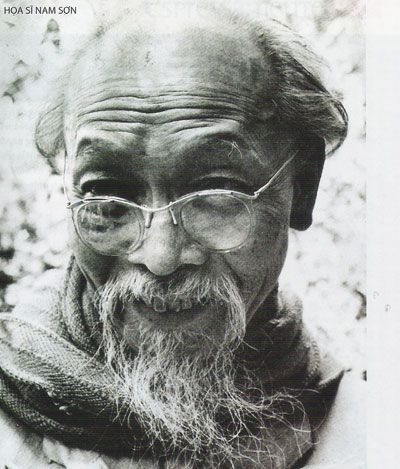
A Historic Encounter
Born in a well-educated family in Hanoi, Nam Son was named Nguyen Van Tho by his parents with the hope of “van an the duc”. His father was the Confucian Nguyen Van Khang, former Secretary of the Tonkin governor’s palace; he passed away when Nam Son was only 4 years old. His mother lived alone and brought her children up by herself. She was awarded the title of “Tiet hanh kha phong” by King Bao Dai.
During his school years at Buoi school, Nguyen Van Tho soon revealed his talent and his passion in painting. At that time, there weren’t any teachers or fine art schools in Vietnam, he had to study by himself through folk paintings, Chinese paintings and Japanese paintings.
At the age of 18, he worked for Indochina Department of Finance but he still devoted to painting. He was known to be a talented painter by many people in Hanoi, even the scholars Tran Trong Kim and Do Than invited him to draw the cover and illustrate their studies. From then on, he was called Nam Son (his pen name). Afterwards, both Nam Phong magazine and Indochina magazine asked him for illustration painting.
In 1923, Nam Son was well-known for painting; hence, he was invited to take responsibility for textbook illustrations. Surprisingly, at that time, the famous French painter Victor Tardieu who was 20 years older than Nam Son won the prize for fine art seven times including the French National Award. He went to Vietnam to learn Eastern fine arts and create more artworks. On his visit to Vietnamese student Club held by Paul Monet at No.9 Vong Duc, he met and was immediately attracted by Nam Son who was helping Paul Monet decorate the club. This encounter was a starting point of their friendship.
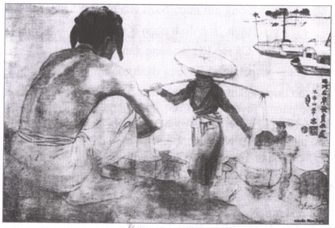
After watching Nam Son’s painting, Tardieu realized that Nam Son learnt painting by himself through Eastern paintings and he tended to get access to Western fine arts because his brushstrokes were free and real. More importantly, Tardieu discovered Nam Son’s talent for painting, thus, he helped Nam Son to get acquainted with the techniques and materials of Western fine arts including mixing colors, stretching fabrics and adjusting lights. After that, Nam Son was the first Indochina painter to execute lacquer paintings following the Impressionism; those artworks were Vietnamese woman, Northern Confucian. In 1923, they were displayed at a fair show that brightened the whole wall as Nam Phong magazine and several newspapers praised. From then on, Nam Son thought that Victor Tardieu could instruct him in painting so he could instruct other Vietnamese talented painters as well. Additionally, he raised the hope of establishing a fine arts school in Vietnam. After helping Tardieu to work on the large-sided painting in the auditorium of Hanoi Medical University, Nam Son mentioned his desire for the establishment of a fine arts school to Tardieu. Tardieu neither opposed nor supported the suggestion.
A Tireless Attempt
Establishing a fines art school and managing it meant that living far from Paris and the family. At that time, Tardieu was 53 years old and he wanted to devote his entire time to painting. His wife, after winning the first prize of French Academy of Music, just opened extra classes at home; hence, it was hard for her to leave France. His son – Jean Tardieu, a young talented poet always needed Tardieu’s help regarding the experiences in art. Therefore, Tardieu faced a dilemma and he deliberated on whether to establish a fine art school in Vietnam.
Not only Nam Son but also many other fine art talents desired for the domestic art. If they had teachers and school, they would be on a par with overseas painters.
Due to Tardieu’s sense of true humanity, he wrote about Annam art in the past, present and future in his report sent to France. In terms of Annam art’s future, he mentioned the establishment of a fine arts school in Indochina.
Nam Son marked an important milestone in his life on October 24th, 1924 when he received the French Government’s decree regarding the establishment of the Indochina Fine Arts College and Victor Tardieu would be the principal. In the late 20th century, it was reported that painter Nam Son – Nguyen Van Tho exerted a strong influence on Tardieu’s decision to found the Indochina Fine Arts College. The book Paris – Hanoi – Saigon – The adventure of contemporary Vietnamese fine art published by the museums in Paris in May, 1998, wrote: “In a decree of Merlin Governor, the Indochina Fine Arts College was officially established. This school was the result of the great friendship between Victor Tardieu and Nam Son… Nam Son persuaded Victor Tardieu to create advocacy for the purpose of opening and operating the school … the first stage was difficult but eventually, it was successful.”
After receiving the decree on the establishment of the Indochina Fine Arts College, Victor Tardieu sent Nam Son to France to buy necessary equipment and recruit teachers. Nam Son worked as a secretary on that journey. Tardieu and Nam Son were really pleased to invite Painter Joseph Inguimberty to Hanoi to recruit and teach students at the college. At that time in France, thanks to Tardieu’s introduction, Nam Son learnt painting from the professional painter Jean Pierr Laurens at the French Academy of Fine Arts in the morning. In the afternoon, he learnt decoration from the well-known decorator Felix Aubert at the French National School of Decorative Arts, and he visited the museums in Paris on Sunday.
When he studied at French National School of Fine Arts, he made friends with the Chinese painter Tu Bi Hong and the Japanese painter Foujita. Thanks to that journey, Nam Son had a chance to strive to acquire painting skills of Western fine arts in Paris – the capital of the world art.
The Teacher of Famous Vietnamese Painters
Not everyone knew that when coming back to Vietnam to recruit students, painter Tardieu was sick and he had to stay in Paris to receive treatment. Therefore, Nam Son had to take charge of all activities of the college including administrative management, exam monitoring, exam marking and admission with 522 candidates in Indochina. He had to select 10 students for the first class (1925-1930) before the opening day of the college. Of these students, Cong Van Trung was a special one. Because he sent his entrant profile to the French Ministry of Education (Paris), he was not called to take the examination while other candidates (270 candidates) were called into the examination room.
Although he was disappointed, Truing still stood outside the examination rooms every day so he made an impression on Nam Son. At the end of the exam, Cong Van Truing was invited to the office. Nam Son just received his entrant profile from France and said: “Due to my carelessness, it turns out to that… On behalf of the examiners, I allow you to get the next day off and you will attend the exam of the final subject with other candidates. This subject is graphics lasting for 6 sections with three hours per section. You have to be there half an hour before the exam to get eraser, easel, palette, charcoal, ruler and other painting tools. After sitting the exam of this subject, I will examine you when you take other exams alone.” At that time, Cong Van Truing felt surprisingly happy. Nam Son motivated Cong Van Trung to rank 5th in 10 students admitted and then, he became a professional painter in Vietnamese fine arts.
At that time, although Nam Son had a wide knowledge of painting and worked as a real professor, he was still called an assistant lecturer. It was not until 1927 that he was regarded as a professor. Nevertheless, his students always considered him as their beloved teachers and the pride of Vietnamese Fine Art. Many of them became master painters in Contemporary Vietnamese Fine Art such as To Ngoc Van, Nguyen Gia Tri, Tran Van Can and Nguyen Tu Nghiem. They had a great respect for the teacher and painter Nam Son – Vietnam’s pride.
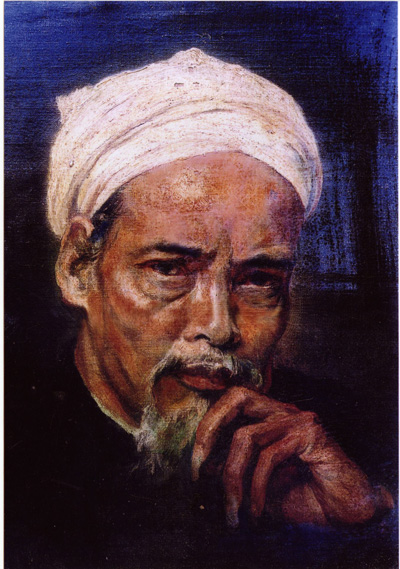
The portrait Northern Confucian was the first lacquer painting of a Vietnamese painter. It was painted in 1923 following the prototype of Nguyen Si Duc – Nam Son’s uncle. He was a Confucian taking part in Dong Kinh Nghia Thuc Movement.
Victor Tardieu worked as the principal of the Indochina Fine Arts College for 12 years and he passed away in Hanoi in 1937. Nam Son continued teaching until the college stopped working in 1945. After Tardieu’s death, Nam Son and other professors trained painting talents in Vietnam such as Diep Minh Chau, Pham Tang, Pham Viet Song, Phan Ke An, Bui Xuan Phai, Si Ngoc, Nguyen Sang, Duong Bich Lien, Quang Phong, Manh Quynh, Ton Duc Luong, etc. They are master painters creating the contemporary Fine Arts of the Socialist Republic of Vietnam.
In 1940, the World War II broke out and exerted an influence on Vietnam. Thanks to painter Nam Son’s great attempt, the Indochina Fine Arts College was still able to admit students. At that time, To Ngoc Van who was an old student of the Indochina Fine Arts College and became a famous painter was invited to teach at this college. Later, painter Phan Ke An said that: “Nam Son was a strict teacher at college but he was very sociable in daily life. Once people in the college went to Son Tay to escape from the allied bombing, they stayed with local residents and studied in the Temple of Literature. At that time, the fighting between Japan and France broke out; hence, Nam Son took over as Principal to maintain the courses.
Many students and I performed an experiment with a new art genre. Suddenly, Inguimberty, Nam Son and To Ngoc Van came to check on us. We had to hide our experimental paintings and only showed them casual paintings. When they left, Nam Son came back and took a glance at us: “hey, you guys just lied foreigners but you couldn’t lie me”, he said with a smile.
Painter Ton Duc Luong remembered that: “Father Nam Son always rode a brown Peugeot bike having bells, lights and brakes. One day, his bike was painted yellow by us. After school, Father Nam Son stared at his bike and left it there then, he walked home. The bike was abandoned in 2 days that made us really afraid and felt guilty. Fortunately, on Tuesday, the pouring rain cleaned the bike and in the afternoon, he biked home. It is an enduring memory that made us have the great respect for him.”
Over the teaching period at the Indochina Fine Arts College, Nam Son was not only a teacher gaining students’ deep respect but also a master painter creating masterpieces including the first oil paintings Vietnamese Woman, Northern Confucian (1923); the famous chalk-colored painting Portrait of Sung Am Tuong (1927), the silk painting Come back to the market (1927); the Chinese brush painting “Rice Market by Red River” – the prize for Fine Art (France, 1930), bought and displayed at the Paris National Museum by the French Government (1930); the seven-colored wood carving sculpture White stork and gold fish – the prize for art (Roma, Italy, 1932), the oil painting Portrait of my mother – silver medal on the Fine Art exhibition in France, 1932,etc.
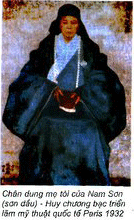
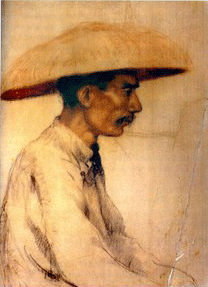
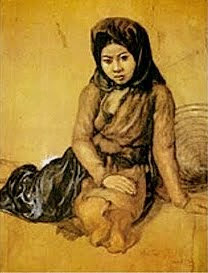
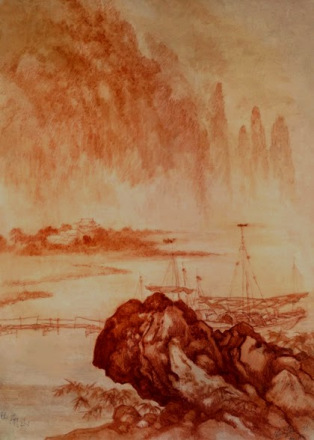
The artwork The natural landscape painted with lead (64x50cm, 1956) was one of two paintings that Nam Son introduced on the exhibition from Red River to Mekong River at Cernuschi museum (Paris) (21/09/2012 – 27/01/2013)
In 1945, Painter Nam Son joined French Resistance. Until 1957, at the congress on the establishment of Vietnam Fine Arts Association, he was elected as Member of the Executive Board I. Over the next few years, Nam Son was well-renowned for his artworks such as landscape paintings, the Chinese finger painting and the beautiful lead painting The dream about resistance. On January 1st, 1973, painter Nam Son passed away at No. 68 Nguyen Du street, Hanoi.
Painter Nam Son gained a deep respect from many generations of young Vietnamese painters. His family still preserved his written words: “In 1930 and 1935, when the French Ministry of Education and Fine Arts bought two of my paintings, one painted with Chinese ink (Rice Market by Red River) and the other was a silk painting (Countryside girl), and when I received the silver medal… The newspapers in Paris paid Vietnamese Fine Art compliments. At that time, I felt happy that Vietnamese people had ancient culture and any countries could not civilize our country anymore!” In 2003, on the 30th anniversary of Nam Son’s death, painter Cong Van Trung (96 years old) said to his children and students: “The Indochina Fine Arts College could not exist without Nam Son as well as Cong Van Trung could not succeed without Nam Son!”
According to Hanoi Bao Moi.
Painter Nam Son – a patriotic Confucian turned to a pioneer of fine arts.
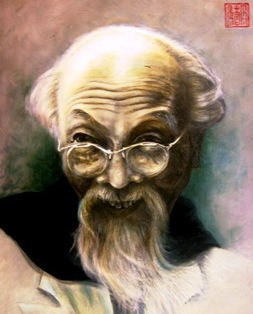
Nam Son was also known as Nguyen Nam Son and his real name was Nguyen Van Tho (1890-1973). His original homeland was Yen Lac district, Vinh Phuc province. He was born and brought up in Hanoi, and became one of the first Vietnamese painters in the contemporary fine arts. He and the French painter Victor Tardieu were founders of the Indochina Fine Arts College. He taught at this college as a second-level professor in charge of Graphics and Decoration. He was the first and only Vietnamese one to take over the college as Principal during the period from March, 1945 to late 1945 (Japanese troops invaded French Indochina). At that time, most of French professors were put in jail and sent to France. In late 1945, the college stopped working and then opened in the war zone of Northern Vietnam with the name Fine Arts High School and To Ngoc Van was the principal of the school.
On the 38th anniversary of Nam Son’s death (26/01/1973), we would like introduce the article of writer Huu Ngoc from a deeply cultural perspective. The article was posted on Viet’s soul magazine with the title: “A patriotic Confucian turned to a pioneer of Contemporary Vietnamese fine arts in the 20th century”
The article attached a portrait of Painter Nam Son painted with oil paint in 2003 – imitating his photo taken by photographer Nguyet Dieu – the manager of the famous studio Yellow Sun in Hanoi. Before me, likewise, on the basis of the photo, painter Van Len executed a successful painting with colored powder on scabrous paper following Pastel style. This painting was bought by An Kieu – Nam Son’s son. Actually, we could not call our paintings portraits, we just showed our great respect and admiration for Nam Son – a giant tree of Vietnamese Fine Arts having greatest portraits in Vietnam.
In this spring, on the National Memorial Day, we would like copy an article written by Huu Ngoc – a cultural researcher having great prestige was called culture exporter-importer by foreigners. He was an eyewitness in Hanoi, at the age of 93, he still taught foreigners culture in English and French.
A patriotic Confucian Turned to a Pioneer in Contemporary Vietnamese Fine Arts in the 20th Century.
Nam Son’s large-sided painting (1,7x4m) “The Forest Landscape in Viet Bac” painted with Chinese ink following Eastern style embellished the living room of the administrative center of Northern Vietnam (in the 1950s in the 20th century) when Hanoi was occupined by the French. After that the government resisted French troops and took over Hanoi (1954) but this painting disappeared, some people agued that it was sold abroad.
Not everyone knew that the painting was executed half a century ago and it remained a secret. According to Nguyen An Kieu (Nam Son’s son), a charity met Nam Son to persuade him to raise money for Vietnamese orphans. Immediately, he offered this painting to the charity and it was fetched at auction to raise funds. The administrative center of Northern Vietnam bought and hanged it on the wall in the living room without understanding the artistic intention.
At that time, Nam Son was stuck for 5-6 years since the French colony fighted aother battle (1946). Among all people, Nam Son had a great prestige as he was co-founder of the Indochina Fine Arts College (1925). He was a good teacher, paved the way for Contemporary Vietnamese Fine Arts and trained many generarions of talented painters in Vietnam. He refused to reopen the Fine Arts school in Hanoi. Afterwards, another Vietnamese painter got this job in 1954 and Nam Son taught at a high school to escape from spies who used to consider him as rigid and uncooperative intellectuals.
Drawing Viet Bac forest landscape helped Nam Son show his patriotism and convey his message about the French Resistance. Viet Bac is an emblem of our Fortress of Resistance. Take a view to white clouds, a flock of birds was flying in the shape of M. The letter M splited into 2 letters V-M (Viet Minh); M also stood for Minh (Ho Chi Minh). Over a few days before September in 1945, Nam Son and his students at the Indochina Fine Arts College evacuated to Son Tay (1943) and held 2 exhibitions with their artworks expressing the patriotism. Nam Son did the painting Mandate of Heaven:
“Nam quoc son ha Nam de cu
Tiet nhien dinh phan tai thien thu
…………..”
Shortly after the August Revolution, Nam Son was appointed to the Board of Management in charge of the French School of the Far East, now it is the Museum of Vietnamese History (Member of Advisory Board). From 1957 to 1973 (at the age of 83), he was a member of the Executive Committee of Vietnam Fine Arts Association and continued painting until his death (1973), he left more than 400 artworks of all art genres.
Nam Son was very humble and lived quietly, discreetly without any fanfare or profits. Thus, few people had a chance to admire his artworks and knew him as a painter winning many international prizes in Paris and Rome. Therfore, many people misunderstood that he could not draw anything.
Like other Vietnamese Confucian, Nam Son also esteemed Uncle Ho. He somewhat took after Uncle Ho. In 1947, when he painted destroyed streets in Hanoi to record the traces of the war, he was catched by a French troop, one of them thought that he was Uncle Ho.
The paintings of ruined lanscapes of Hanoi were the remnant of historic fine art data and were not still introduced because Nam Son was the only painter to paint those landscapes. Painter Luu Cong Nhan was one of a few people watching those paintings in late 1954.
Until the capital was liberated (1954), Nam Son had an opportunity to publicly convey his passion in lead paintings (Sanguine): Nation’s soul, Marching, Wartime dream, The dream of a student sleeping on Vietnamese History book, she dreamt about Uncle Ho and the soldiers.
Nam Son executed an oil painting 80 years ago prior to the establishment of the Indochina Fine Arts College. It was Bac Ha heroes (1923) hiding a political meaning. The portrait of Nguyen Si Duc who joined Dong Kinh Nghia Thuc Movement and was Nam Son’s teacher with Eastern style portrayed Nguyen Si Duc with weepers, tears and bright eyes when Dong Kinh Nghia Thuc was brutally suppressed by the French colony (1907).
At that time, Nam Son lived in Hang Be street, behind The Tonkin Free School (Hang Dao street, Hanoi). After displaying the painting to introduce the cover of the book Nho Phong (written by Nhat Linh and now preserved in Hanoi National library – No. P (12) 9838), Nam Son hided the painting on the altar as spies realized it expressed his patriotism and praise for Dong Kinh Nghia Thuc Movement.
Until 2000, the painting Bac Ha heroes was widely publicized on the newspapers in Vietnam by Nam Son’s family, at the same time, even painter Cong Van Trung (96 years old – a student of the first class of the Indochina Fine Arts College) first watched that painting.
Unlike other well-known painters in the same period, Nam Son never painted portraits of governors, French envoys, Vietnamese mandarins, rich people, etc. He usually drew pagodas, monks, landscapes, labour, farmers, even beggars (like the Spanish painter Murillo in the 27th century). He raised a high hope of improving the quality of Vietnamese craft to compete with the international market. Thus, he turned decoration into craft when teaching at the Indochina Fine Arts College. He explained it clearly 73 years ago in the report of the journalist Hoang Tich Chu (Dong Tay Newspaper – Hanoi, January 1930).
Nam Son was born in 1890 and his age was same as President Ho Chi Minh’s when Vietnam was invaded by the French for a decade. The colonialism initially formed a solid basis. The modernization of Vietnamese intellectuals lasted for plenty of generations regardless of Southern pioneers such as Truong Vinh Ky, Paulus Huynh Tinh Cua. We could devide them into 3 generations:
1. The first generation: The Confucians had expertise in Chinese and National Language (born in 1970s in the 19th century) such as Phan Chu Trinh, Huynh Thuc Khang.
2. The second generation: People born in the 1980s and 1990s in the 19th century had a good command of French. They used National Language rather than Chinese.
3. The third generation: People born in the first 25 years in the early 20th century had expertise in Vietnamese, French even Chinese such as Dao Duy Anh, Hoang Xuan Han and Dang Thai Mai.
It was an honor for the second generation that President born in 1890 with many reseachers such as Nguyen Van To born in 1899, Duong Quang Ham born in 1898, etc. They were influenced by the Confucianism and lived among plenty of movements like Can Vuong Movement, Dong Kinh Nghia Thuc Movement, etc…, and had a good command of Sinologist and French literature.
In dissimilar positions with different statuses, circumstances and conditions, the intellectual elite of this generation cultivated Eastern-Western culture to make significant contributions to the country.
(Huu Ngoc)
According to Nguyen Van Luong, Nam Son gained a deep respect from overseas newspapers, famous painters and his students (were living abroad) as he was the first Vietnamese one to become an art professor at the Indochina Fine Arts College (under Indochina University), a first-level professor (recorded in a decree in January, 1946 of Mr. Vu Dinh Hoang Minister of education of the Socialist Republic of Vietnam), a Vietnamese painter having an artworks bought and displayed at the French National Museum (Rice Market by Red River, 1930). In addition, he won a silver medal in Salon de Paris in 1932 with the oil painting Portait of my mother and received the highest fine art medal in Paris among Vietnamese painters.
To be more specific, there weren’t any Vietnamese painters winning a gold medal on fine arts exhibitions in Paris as some people at Hanoi University of Fine Arts said. They were wrong when they mentioned the colonial exhibition in Vicennes! The exhibition in Vincennes was only an exhibition of the French colony at that time! It was NOT an art exhibition, hence, there weren’t any art prizes being awarded.
The art exhibition in Salon de Paris was the only one to give prizes including Premier League prize, Gold Medal, Silver Medal, Bronze Medal and Honorable Mention Award certificate (Painter To Ngoc Van received Honorable Mention Award certificate in Salon de Paris in 1932 with his artwork “The Letter”).


